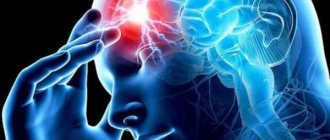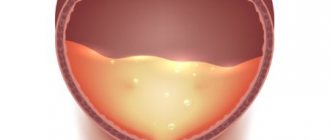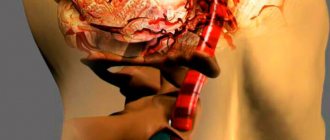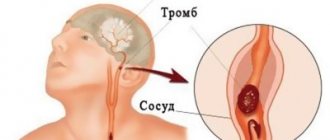Acute cerebrovascular accidents (ACVA) are associated with a decrease or cessation of blood flow to a certain area of the brain. The result is neurological dysfunction and deficits of varying degrees. Almost 50% of people die during hospitalization and over the next month. Approximately 90% of survivors are left with severe neurological impairment and disability. Approximately 20% of cases are hemorrhagic and 80% are ischemic strokes.
Clinical picture
There are two types of stroke based on pathophysiology:
- ischemic – associated with blocking blood flow to the brain;
- hemorrhagic - caused by rupture of the vascular wall, hemorrhage and soaking of brain tissue with blood.
It is possible to determine what type of stroke occurred in a patient only after the lesion has formed. The clinical picture shows some features of the pathology.
Hemorrhagic strokes are divided into intracranial and subarachnoid hemorrhages. Predisposing factors are high blood pressure, previous myocardial infarction and thrombolytic therapy, and less commonly, vascular malformations of the circle of Willis.
An acute onset and rapid development of symptoms are characteristic of hemorrhages. Headache, vomiting and hypertensive crisis are obvious signs. Local neurological manifestations occur within a few minutes.
There are three main etiologies of ischemic stroke: hypoperfusion, embolism, and thrombosis, which are the most common cause of out-of-hospital attacks. The manifestation unfolds slowly, over several hours, with varying degrees of severity. Covers paresis, ataxia, paralysis, vomiting, visual impairment, depending on the region affected.
Ischemic stroke
There are two main types of ischemic stroke:
- Thrombotic - occurs when the artery leading to the brain becomes thrombosed.
- Thromboembolic - develop due to clots formed in another part of the body and traveling through the bloodstream to the brain.
Ischemia is the most common type of stroke with characteristic symptoms: weakness or numbness on one side of the body, feelings of anxiety and fear, problems with vision and balance.
The two syndromes have different predisposing factors:
- Emboli occur against the background of arrhythmia, aortic aneurysm, left ventricular enlargement, mitral valve stenosis and atrial septal defects.
- Thrombosis is usually associated with lifestyle factors: smoking, diabetes, high cholesterol, heart failure.
Despite the different etiology, acute ischemia manifests itself in the same way - cortical infarctions - damage to parts of the cerebral cortex.
Hemorrhagic stroke
Hemorrhagic stroke is associated with a rupture of a vessel and blood entering the brain tissue. Sudden headache precedes hemorrhage.
Hemorrhages are less common - approximately 15% of all cases. Develop according to one of two scenarios:
- Intracerebral - bleeding into the medulla due to hypertension.
- Subarachnoid - damage to the artery in the cavity between the arachnoid and soft membranes.
Risk factors
Risk factors are various clinical, biochemical, behavioral and other characteristics that indicate an increased likelihood of developing a certain disease. All areas of preventive work are focused on controlling risk factors and their correction both in specific people and in the population as a whole.
- High cholesterol and LDL (low-density lipoprotein) levels in the blood
- Arterial hypertension
- Diabetes
- Heart diseases (arrhythmia, etc.)
- Sedentary lifestyle
- Excess weight
- Age
- Smoking
- Addiction
- Alcoholism
- Blood clotting disorders
- TIA (transient ischemic attack) is a significant predictor of the development of both cerebral infarction and myocardial infarction
- Sleep apnea
- Previous history of stroke, heart attack, or TIA
- Carotid artery disease (Asymptomatic carotid artery stenosis[34], etc.)
- Peripheral vascular disease
- Fabry disease[35].
- High performance sport
Many people in the population have several risk factors simultaneously, each of which can be moderately expressed. There are scales that allow you to assess your individual risk of developing stroke.
Difference between hemorrhagic stroke and ischemic stroke
It is difficult to distinguish hemorrhage from ischemia, since even MRI displays a complete picture of the lesion only after 24 hours.
With intracerebral hemorrhages, brain tissue is compressed, and symptoms increase over several seconds or minutes. Focal and cerebral symptoms appear immediately or within an hour. With ischemia, the clinical picture develops stepwise, which reflects worsening disturbances in hemodynamics and tissue metabolism. The area of cerebral infarction is formed over 3-6 hours, and the focus continues to grow for another two days.
The symptoms of each type of pathology are not specific. Generalized or brain-wide signs include:
- nausea;
- vomiting;
- headache;
- change of consciousness.
They appear with an increase in intracranial pressure, therefore they are characteristic of hemorrhage or a large focus of ischemia.
Convulsions are more common in the hemorrhagic type of pathology than in the ischemic type: in 28% of cases before hemorrhage, at the very beginning or during the first day.
Neurological focal deficit reflects the area of the brain that was involved:
- weakness or paresis of one limb, half of the body or four limbs;
- sagging of one side of the face;
- impaired binocular vision;
- lack of focus or loss of field of vision;
- problems with speech and its perception;
- dizziness, unsteadiness of gait;
- problems with coordination and balance.
In right-handed people, when the left dominant hemisphere is damaged, right hemiparesis develops, vision in the left eye is impaired, but the field of vision in the right eye is reduced. Speech typically suffers.
If the right non-dominant hemisphere is damaged, hemiparesis develops on the left, the field of vision of the left eye suffers, but vision on the right deteriorates. Spatial neglect is possible, when the patient simply does not notice what is to his left.
The differences in hemorrhage and ischemia are that these signs of a hemorrhagic stroke appear in aggregate and almost immediately. The causes of occurrence, temporal features, predisposing factors of three types of cerebrovascular accidents are described in the table.
| Type of pathology | Ischemic | Inside the brain | Into the subarachnoid space |
| Cause | Thrombus, embolus, hypotension, damage to small vessels due to hypertension | Spasm of the cerebral arteries, a sharp increase in the permeability of the vascular walls | Aneurysm rupture in 50-85%, traumatic brain injury |
| Age | Average age 60 years | From 45 to 60 years | From 30 to 60 years |
| Risk factors | Atherosclerosis, heart defects, endocarditis, decrease or increase in blood pressure | Hypertension in 85% of cases, atherosclerosis of cerebral arteries, blood diseases | Smoking, alcoholism, single large doses of alcohol, hypertension, overweight, cocaine use, bleeding disorders |
| Time | Thrombotic occurs during sleep; embolic against the background of an arrhythmia attack | During the daytime against a background of severe stress | Spontaneously while awake |
| Symptoms | They grow in steps, gradually | Onset quickly, significantly expressed | Rapid, with the addition of aseptic meningitis |
Treatment and rehabilitation
After a diagnosis of cerebral infarction is made, specific or nonspecific treatment is prescribed. The first is aimed at stabilizing blood circulation, respiratory function, cardiac muscle function and preventing post-stroke complications. The second includes a set of procedures to prevent the development of thrombosis.
Hemorrhagic stroke can be treated with medication or surgery. Drug therapy is prescribed based on the severity of the pathology, the individual characteristics of the patient and other factors. Surgery is necessary to eliminate the hematoma by cutting it out.
To restore a patient who has suffered a stroke, a special program is being developed. At this stage, it is very important to ensure that the instructions are followed correctly and regularly. Patients often become depressed when they find themselves in an emotional vacuum, so loved ones need to make every effort to ensure that the victim feels not only physical, but also psychological comfort.
To prevent stroke, you should promptly treat hypertension, eliminate arrhythmia and monitor your general health. You should also give up bad habits, including alcohol, smoking and unhealthy foods. Of course, no one is immune from the onset of the disease. But in order to provide the victim with timely assistance, which can save a life and increase the chances of a successful recovery, it is necessary to know the main differences between a hemorrhagic stroke and an ischemic one.
Which stroke is more dangerous?
Each type of stroke is life-threatening and associated with neurological deficits. In ischemic stroke caused by a blood clot, tissue plasminogen activator, when administered in a timely manner, reduces the lesion. For hemorrhagic, surgical methods of therapy are used.
Ischemic stroke may be associated with poor outcome when large arteries, such as the basilar and vertebral arteries, are blocked. With occlusion on both sides, we develop “locked-in syndrome”, coma and tetraplegia.
The most terrible types of strokes are:
- Damage to the brain stem, where impulses travel from the brain to the body. Here is the respiratory center of cardiac activity, which controls blood vessels and heart rate. Damage to the trunk is associated with impaired consciousness. Even with a small lesion it leads to hemiplegia, paralysis and visual impairment. Stroke is often lacunar due to damage to the perforating arteries due to hypertension.
- Lesions occur in areas of adjacent circulation, usually occurring in the area between the anterior and middle cerebral arteries. They occur against the background of a sharp drop in blood pressure. Thrombosis of the carotid artery provokes heart attacks in a similar adjacent zone. They cause bilateral vision loss, stupor, and proximal limb weakness without affecting the face, arms, and legs. Occurs against the background of dehydration, infections, heart attack.
- Hemorrhagic strokes are extremely more dangerous than ischemic strokes, since the entry of blood into the substance leads to further complications such as hydrocephalus, increased intracranial pressure and vasospasm.
- Large thromboses are dangerous because they block the blood flow of major highways. Ischemia of the middle cerebral artery often leads to edema. The mass of intercellular fluid with inflammatory cells compresses the surrounding tissue, which can lead to impaired consciousness, herniation of brain tissue, and death due to compression of the medulla oblongata.
The consequences of an ischemic stroke depend on the location and rate of administration of drugs to dilute the blood clot. Hemorrhagic infarction differs from hemorrhage in that it occurs after ischemia and occurs in the cerebral cortex. Together, all types of strokes are associated with a risk of death, but with hemorrhage, this risk persists throughout the first month.
Forecast
After suffering any type of stroke, the prognosis for successful recovery is poor. With ischemia, the number of deaths reaches 25%, disability – 30%. With a cerebral hemorrhage, death ends in 50–70% of cases, and disability in 30–40%.
Note! There are often cases when, some time after the patient’s condition improves, the patient becomes worse and falls into a coma.
According to statistics, only 25% of people who have suffered an ischemic stroke return to a full life and live for at least 10 years. In the case of hemorrhagic stroke, this figure is much lower.
Prevention
The consequences of cerebral hemorrhage are very serious. Therefore, it is necessary to take all available preventive measures to prevent the dangerous development of the pathological process:
- Eliminate provoking factors as much as possible, especially in people over 40 years of age.
- Treat hypertension.
- Get examined in a timely manner if you have frequent headaches or surges in blood pressure.
About 70% of stroke patients die for the following reasons:
- Old age (over 70 years old).
- Concomitant disorders and diseases of internal organs.
- Extensive hemorrhage and multiple hematomas.
- Brainstem stroke.
Timely treatment, long-term rehabilitation in special centers, compliance with all doctor’s orders and careful attitude towards one’s health allows the patient to survive. People who know first-hand what a hemorrhagic stroke is, in most cases remain disabled, since dead cells and brain structures cannot be completely restored.
Causes of the disease
Causes of ischemic stroke
Development of ischemic stroke
The causes of ischemic stroke are divided into:
Cardioembolic - occurs as a result of blockage of the artery lumen by an embolus. A common cause of blockage is emboli that occur due to heart defects, endocarditis, and other heart pathologies accompanied by the formation of blood clots. A common cause is atrial fibrillation.
Atherothrombotic - usually manifests itself as a consequence of atherosclerosis of large and medium arteries. The plaque narrows the lumen of the vessel and is a catalyst for the formation of a blood clot. This type develops gradually and often culminates during sleep. Often the harbinger is a transient ischemic attack.
Hemodynamic – caused by a change in the normal speed of blood movement through the vessels. The onset of the hemodynamic type of the disease can be different and manifest itself both during sleep and during wakefulness.
Lacunar – damage to the small vessels of the brain. A common cause is prolonged high blood pressure.
Rheological - occurs due to changes in the properties of blood. Thrombophilia, leukemia, erythrocytosis, erythremia can lead to a rheological type of disease.
Causes of hemorrhagic stroke
- Most often develops against the background of hypertension of 2 and 3 degrees. If a patient with hypertension has endocrine pathologies in the form of a pituitary adenoma, changes in the thyroid gland, then the possibility of the disease doubles.
- Aneurysm rupture.
- Pathological processes of connective tissue, during which a violation of the elasticity and strength of blood vessels occurs.
- Hemophilia.
- Overweight.
- Bad habits.
- Changes in lipid metabolism.
- Diabetes.
- Heart diseases.
- Depressive states.
Based on the above reasons, it is clear that the difference between hemorrhagic and ischemic stroke is that most often ischemic stroke is caused by diseases accompanied by the formation of emboli and blood clots, and in hemorrhagic stroke, the main catalyst is a history of hypertension.










